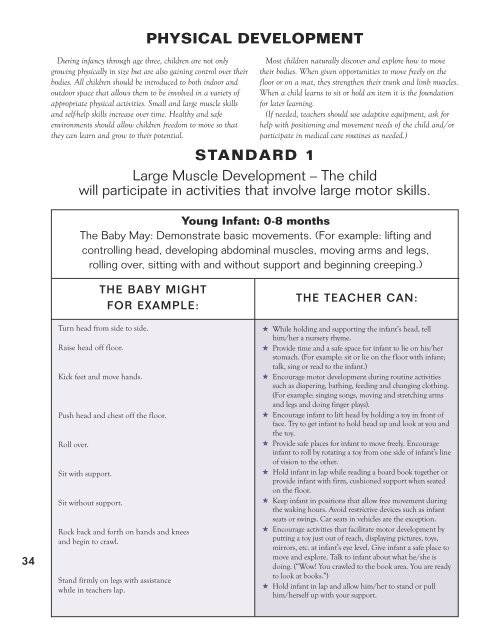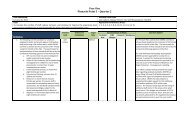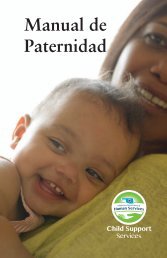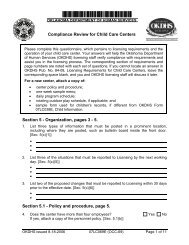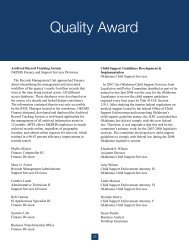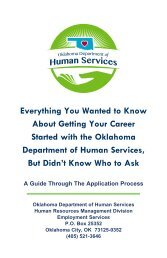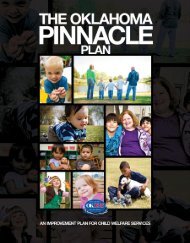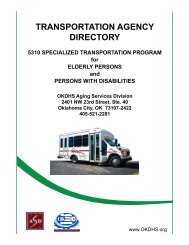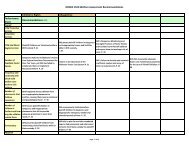Oklahoma Early Learning Guidelines for Infants, Toddlers and Twos
Oklahoma Early Learning Guidelines for Infants, Toddlers and Twos
Oklahoma Early Learning Guidelines for Infants, Toddlers and Twos
Create successful ePaper yourself
Turn your PDF publications into a flip-book with our unique Google optimized e-Paper software.
34<br />
PHYSICAL DEVELOPMENT<br />
During infancy through age three, children are not only<br />
growing physically in size but are also gaining control over their<br />
bodies. All children should be introduced to both indoor <strong>and</strong><br />
outdoor space that allows them to be involved in a variety of<br />
appropriate physical activities. Small <strong>and</strong> large muscle skills<br />
<strong>and</strong> selfhelp skills increase over time. Healthy <strong>and</strong> safe<br />
environments should allow children freedom to move so that<br />
they can learn <strong>and</strong> grow to their potential.<br />
Most children naturally discover <strong>and</strong> explore how to move<br />
their bodies. When given opportunities to move freely on the<br />
floor or on a mat, they strengthen their trunk <strong>and</strong> limb muscles.<br />
When a child learns to sit or hold an item it is the foundation<br />
<strong>for</strong> later learning.<br />
(If needed, teachers should use adaptive equipment, ask <strong>for</strong><br />
help with positioning <strong>and</strong> movement needs of the child <strong>and</strong>/or<br />
participate in medical care routines as needed.)<br />
STANDARD 1<br />
Large Muscle Development – The child<br />
will participate in activities that involve large motor skills.<br />
Young Infant: 08 months<br />
The Baby May: Demonstrate basic movements. (For example: lifting <strong>and</strong><br />
controlling head, developing abdominal muscles, moving arms <strong>and</strong> legs,<br />
rolling over, sitting with <strong>and</strong> without support <strong>and</strong> beginning creeping.)<br />
THE BABY MIGHT<br />
FOR EXAMPLE:<br />
Turn head from side to side.<br />
Raise head off floor.<br />
Kick feet <strong>and</strong> move h<strong>and</strong>s.<br />
Push head <strong>and</strong> chest off the floor.<br />
Roll over.<br />
Sit with support.<br />
Sit without support.<br />
Rock back <strong>and</strong> <strong>for</strong>th on h<strong>and</strong>s <strong>and</strong> knees<br />
<strong>and</strong> begin to crawl.<br />
St<strong>and</strong> firmly on legs with assistance<br />
while in teachers lap.<br />
THE TEACHER CAN:<br />
★ While holding <strong>and</strong> supporting the infant’s head, tell<br />
him/her a nursery rhyme.<br />
★ Provide time <strong>and</strong> a safe space <strong>for</strong> infant to lie on his/her<br />
stomach. (For example: sit or lie on the floor with infant;<br />
talk, sing or read to the infant.)<br />
★ Encourage motor development during routine activities<br />
such as diapering, bathing, feeding <strong>and</strong> changing clothing.<br />
(For example: singing songs, moving <strong>and</strong> stretching arms<br />
<strong>and</strong> legs <strong>and</strong> doing finger plays).<br />
★ Encourage infant to lift head by holding a toy in front of<br />
face. Try to get infant to hold head up <strong>and</strong> look at you <strong>and</strong><br />
the toy.<br />
★ Provide safe places <strong>for</strong> infant to move freely. Encourage<br />
infant to roll by rotating a toy from one side of infant’s line<br />
of vision to the other.<br />
★ Hold infant in lap while reading a board book together or<br />
provide infant with firm, cushioned support when seated<br />
on the floor.<br />
★ Keep infant in positions that allow free movement during<br />
the waking hours. Avoid restrictive devices such as infant<br />
seats or swings. Car seats in vehicles are the exception.<br />
★ Encourage activities that facilitate motor development by<br />
putting a toy just out of reach, displaying pictures, toys,<br />
mirrors, etc. at infant’s eye level. Give infant a safe place to<br />
move <strong>and</strong> explore. Talk to infant about what he/she is<br />
doing. (“Wow! You crawled to the book area. You are ready<br />
to look at books.”)<br />
★ Hold infant in lap <strong>and</strong> allow him/her to st<strong>and</strong> or pull<br />
him/herself up with your support.


